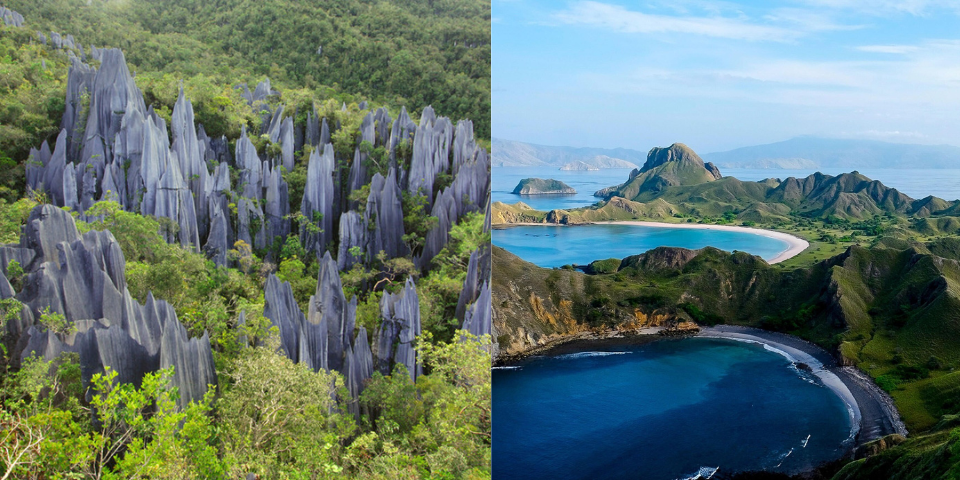Did you know that UNESCO heritage sites also include natural sites like forests and terrains?
In order to get listed on the World Heritage List, the site must fulfill at least one out of ten criteria listed by UNESCO.
There are four in the list of 'natural criteria', which are:
1. To be outstanding examples representing major stages of earth's history, including the record of life, significant ongoing geological processes in the development of landforms, or significant geomorphic or physiographic features.
2. To be outstanding examples representing significant ongoing ecological and biological processes in the evolution and development of terrestrial, freshwater, coastal, and marine ecosystems and communities of plants and animals.
3. To contain superlative natural phenomena or areas of exceptional natural beauty and aesthetic importance.
4. To contain the most important and significant natural habitats for in-situ conservation of biological diversity, including those containing threatened species of outstanding universal value from the point of view of science or conservation.
A majority of Southeast Asian countries have tropical climates, and what loves tropical climates most? Tropic, exotic flora and fauna.
We're here to share some natural heritage sites from Southeast Asian countries that might spike your travel interest.
1. Gunung Mulu National Park, Malaysia.

IMAGE: Malaysia Travel.
Gunung Mulu (Mount Mulu) National Park is located in Miri, Sarawak. It provides significant natural habitat for a wide range of plant and animal species, both above and below ground.
According to UNESCO, Gunung Mulu National Park is an area of exceptional natural beauty, with striking primary forest, karst terrain, mountains, waterfalls, and the largest caves on earth.
It is home to one of the world's finest examples of the collapse process in karstic terrain and provides outstanding scientific opportunities to study theories on the origins of cave faunas.
The deeply-incised canyons, wild rivers, rainforest-covered mountains, spectacular limestone pinnacles, cave passages, and decorations found within the property produce dramatic landscapes and breathtaking scenery that is without rival.
The park is dominated by Gunung Mulu, a 2,377 meters-high (7,798 ft.) sandstone pinnacle. At least 295 kilometers (1,295,931 ft.) of explored caves provide a spectacular sight and are home to millions of cave swiftlets and bats.
The 'Sarawak Chamber' is the largest known cave chamber in the world.
2. Puerto-Princesa Subterranean River National Park, Philippines.

IMAGE: Guide To The Philippines.
Puerto-Princesa Subterranean River National Park has one of the world’s most impressive cave systems, featuring spectacular limestone karst landscapes, pristine natural beauty, intact with old-grown forests, and distinctive wildlife.
It is located in the southwestern part of the Philippine Archipelago on the mid-western coast of Palawan, approximately 76 kilometers (249,343 ft.) northwest of Puerto Princesa and 360 kilometers (1,181,102 ft) southwest of Manila.
The area has an 8.2 kilometer-long (26,902 ft.) underground river that flows directly into the sea with its brackish lower half subjected to tidal influence, distinguishing it as a significant natural global phenomenon.
3. Kaeng Krachan Forest Complex, Thailand.

IMAGE: Globe.
The Kaeng Krachan Forest Complex (KKFC) lies in the Tenasserim Range near the border area of Thailand and Myanmar.
The Forest complex covers vast forest areas stretching across parts of three provinces in the western part of Thailand, namely Ratchaburi, Phetchaburi, and Prachuap Khiri Khan.
It is a combination of three national parks and one wildlife sanctuary.
It is home to a large number of threatened and rare plant species while also maintaining healthy populations of globally important and threatened wildlife species.
4. Phong Nha-Ke Bang National Park, Vietnam.

IMAGE: VietNamNet.
Phong Nha-Ke Bang National Park is located in the middle of the Annamite Mountain Range in Quang Binh province, Vietnam.
The area protects over 104 kilometers (341,207 ft.) of caves and underground rivers, making it one of the most outstanding limestone karst ecosystems in the world.
The karst formation has evolved since the Paleozoic period (almost 400 million years ago) and is the oldest major karst area in Asia.
The Phong Nha cave is the most famous, with tour boats able to penetrate inside to a distance of 1,500 meters (4,921 ft.).
The Son Doong Cave, first explored in 2009, is believed to contain the world’s largest cave passage in terms of diameter and continuity.
5. Komodo National Park, Indonesia.

IMAGE: The World Travel Guy.
Komodo National Park is located in the center of the Indonesian archipelago between the islands of Sumbawa and Flores.
It is composed of three major islands, namely Rinca, Komodo, and Padar, and numerous smaller ones (all of them of volcanic origin).
The park is identified as a priority area for global conservation which comprises unparalleled terrestrial and marine ecosystems.
Komodo National Park contains the majority of the world’s areas in which wild populations of the Komodo dragon lizard still exist.
The park receives strong support and resources from the central government of Indonesia. As a tourism spot, the Indonesian government has a specific program for ecotourism management to promote the park at the international level and to ensure the sustainability of tourism activities.
Sadly, a few Southeast Asian countries do not have UNESCO-certified natural heritage sites. That does not mean those countries do not have World Heritage sites. Their sites are more cultural-based and human-made.
Hey there! Here's what others are currently reading:
Bahasa Indonesia May Soon Become an Official Language of the United Nations
Malaysia & 4 Nations Submit Kebaya To UNESCO To Celebrate Garment's Rich History
Singapore Ranks 5th Least Corrupted out of 180 Countries in 2023’s Corruption Index












